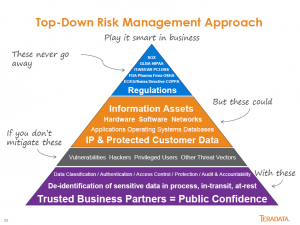Teradata’s recent presentation at the BBBT was very interesting. The focus, no surprise, was on Teradata Aster, but Chris Twogood, VP Products and Services Marketing, and John Thuma, Director of Aster Strategy and Analytics, took a very different approach than was taken a year earlier.
Chris Twogood started the talk with the usual business overview. Specific time was spent on four recent product announcements. The most interesting announcement was about their support for Presto, a SQL-on-Hadoop project. They are the first company to provide commercial support for the open source technology. As Chris pointed out, he counted “13 different SQL-on-Hadoop variants.” Because of the importance of SQL access and the perceived power of Presto, Teradata has committed to strengthening its presence with that offering. SQL is still the language for data access and integrating Hadoop into the rest of the information ecosystem is a necessary move for any company serving any business information market. This helps Teradata present a leadership image.
Discussion then turned to the evolution of data volumes and analytics capabilities. Mr. Twogood has a great vision of that history, but the graphic needs serious work. I won’t copy it because the slide was far too busy. The main point, however, was the link between data volumes and sources with the added capabilities to look at business in a more holistic way. It’s something many people are discussing but he seems to have a much better handle on it than most others who talk to the point, he just needs to fine tune the presentation.
Customers and On-Site Search
As most people have seen, the much of the new data coming in under the big data rubric is customer data from sources such as the web, call logs and more. Being able to create a more unified view of the customer matters. Chris Twogood wrapped up his presentation by referring to a McKinsey & Co. survey that pointed out, among other things, that studying customer journeys can increase predictive accuracy of customer satisfaction and churn by 30-40%. Though it also points out that 56% of customer interactions are through multi-channel means, one of the key areas of focus today is the journey through a web site.
With that lead-in, John Thuma took over to talk about Aster and how it can help with on-site search. He began by stating that 25-30% of web site visitors using search leave the site if the wanted result isn’t in first three items returned, while 75% abandon if the result isn’t on first page. Therefore it’s important to have searches that understand not only the terms that the prospective customer enters but possible meanings and alternatives. John picked a very simple and clear example, depending on the part of the country, somebody might search on crock pot, slow cooker or pressure cooker but all should return the same result.
While Mr. Thuma’s presentation talked about machine learning in general, and did cover some of the other issues, the main focus of that example is Natural Language Processing (NLP). We need to understand more than the syntax of the sentence, but also improve our ability to comprehend semantic meaning. The demonstration showed some wonderful capabilities of Aster in the area of NLP to improve search capabilities.
One feature is what Teradata is calling “apps,” a term that confuses them with mobile apps, a problematic marketing decision. They are full blown applications that include powerful capabilities, applications customization and very nice analytics. Most importantly, John clearly points out that Aster is complex and that professional services are almost always required to take full advantage of the Aster capabilities. I think that “app” does a disservice to the capabilities of both Aster and Teradata.
One side bar about technical folks not really understanding business came from one analyst attending the presentation who suggested that ““In some ways it would be nice to teach the searchers what words are better than others.” No, that’s not customer service. It’s up to the company to understand which words searchers mean and to use NLP to come up with a real result.
A final nit was that the term “self-service” was used while also talking about the requirement for both professional services from Teradata and a need for a mythical data scientist. You can’t, as they claimed, used Aster to avoid the standard delays from IT for new reports when the application process is very complex. Yes, afterwards you can use some of the apps like you would a visualization tool which allows the business user to do basic investigation on her own, but that’s a very limited view of self-service.
I’m sure that Teradata Aster will evolve more towards self-service as it advances, but right now it’s a powerful tool that does a very interesting job while still requiring heavy IT involvement. That doesn’t make it bad, it just means that the technology still needs to evolve.
Summary
I studied NLP almost 30 years ago, when working with expert systems. Both hardware and software have moved forward, thankfully, a great distance since those days. The ability to leverage NLP to more quickly and accurately to understand the market, improve customer acquisition and retention ROI and better run business is a wonderful thing.
The presentation was powerful and clear, Teradata Aster provides some great benefits. It is still early in its lifecycle and, if the company continues on the current course, will only get better. They have only a few customers for the on-site optimization use, none referenceable in the demo, but there is a clear ROI message building. Mid- to large-size enterprises looking to optimize their customer understand, whether for on-site search or other modern business intelligence uses, should talk to Teradata and see if Aster fits their needs.
